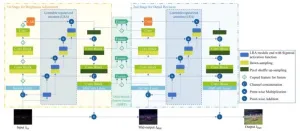(Press-News.org) Bottom Line: The frequency of second primary malignancies (SPMs) arising in cancer survivors following treatment with CAR T-cell therapy was statistically comparable to the frequency of SPMs following other standard-of-care therapies, according to a systematic review and meta-analysis.
Journal in Which the Study was Published: Clinical Cancer Research, a journal of the American Association for Cancer Research (AACR)
Author: Kai Rejeski, MD, a visiting investigator and research fellow in the Adult Bone Marrow Transplant Service at Memorial Sloan Kettering Cancer Center.
Background: In January 2024, the U.S. Food and Drug Administration (FDA) required labeling information for all currently available CAR T-cell therapies to include a boxed warning advising prescribers and patients of the potential risks of a secondary cancer arising after CAR T treatment. Specifically, the boxed warnings alert patients to the possibility of developing new T-cell cancers unrelated to the B-cell lymphoma or multiple myeloma for which the patients received CAR T.
The decision was based largely on data from the FDA Adverse Event Reporting System. However, some researchers have expressed concerns that the data may possess inherent biases, including reporting bias, Rejeski explained. When assessing SPM risk, it is important to account for confounders such as age and follow-up duration, the type of CAR T therapy received, the patient’s initial diagnosis, or other types of treatment the patient may have been given before CAR T, Rejeski noted.
“Patients are reading this in the news and, appropriately, asking questions to providers,” Rejeski said. “We need to understand the potential risks, but at the same time, we need to interpret the data cautiously and contextualize it for our patients.”
How the Study was Conducted: Rejeski and colleagues performed a systematic review and meta-analysis of clinical studies in which adult patients with lymphoma or multiple myeloma received one of the six currently approved CAR T-cell therapies: idecabtagene vicleucel (Abecma), lisocabtagene maraleucel (Breyanzi), ciltacabtagene autoleucel (Carvykti), tisagenlecleucel (Kymriah), brexucabtagene autoleucel (Tecartus), or axicabtagene ciloleucel (Yescarta). To meet inclusion criteria, studies must have provided data on SPM occurrence for the entire follow-up period, which ranged from 6.6 months to 65.4 months. The final selection included 18 clinical trials and seven real-world studies consisting of a combined 326 SPMs in 5,517 patients.
Results: After a median follow-up of 21.7 months, 5.8% of patients developed an SPM. The researchers did not find any significant differences in SPM rates between patients with different cancer types or between patients who received different CAR T-cell products.
Studies in which patients had received a median of more than three lines of therapy before CAR T reported a significantly higher risk of SPMs than studies in which patients received fewer than three prior lines of therapy. Similarly, the rate of SPMs was 4.2% among studies with a follow-up time below the median of 21.7 months and 8.5% among studies with a follow-up time above the median.
Out of 326 SPMs identified in this analysis, hematologic malignancies, including myelodysplastic syndrome and acute myeloid leukemia, accounted for the largest proportion of SPMs at 37%. Five cases were T-cell malignancies, a rate of 0.09% across the entire study population. In three of these cases, the malignant T cells were tested to determine if they contained the CAR transgene (an indicator that the malignancy may have arisen from CAR-edited cells), and one case tested positive.
Four of the clinical trials included in the study assessed the outcomes of patients treated with CAR T therapy in comparison to a standard-of-care regimen. In a total of 1,253 patients across these studies, the rate of SPMs was 5% among patients treated with CAR T and 4.9% among patients treated with the standard of care, a difference that was not statistically significant.
Author’s Comments: “These data do not suggest that there is an increased risk of SPMs relative to other standard-of-care therapies,” Rejeski said. “I worry that the warning labels may intimidate patients who receive this therapy, which may not be entirely founded.”
Rejeski further explained that the study’s data may help identify specific factors that increase the risk of SPMs for patients who receive CAR T. For instance, the increased incidence of SPMs with increasing lines of prior treatment may reflect cumulative damage caused by several previous therapies, Rejeski said. He also stated that an increased risk with longer follow-up time may indicate a survivorship bias, meaning more patients may be developing SPMs because they are living long enough to do so.
“CAR T therapy is the first treatment in more than 20 years to show an overall survival benefit compared to the standard of care in refractory large B-cell lymphoma,” Rejeski said. “I would strongly caution against withholding this therapy because of the miniscule risk of developing T-cell malignancies.”
Rejeski emphasized that more work will be necessary to understand the specific contributions of CAR T-cell therapy to the development of SPMs and to better estimate each patient’s risk on an individual level. He stressed that accurate reporting of SPMs across long-term follow-up periods, especially in clinical trials, will help tremendously with such research.
“We still need to be vigilant in understanding this adverse event, and that means we need to have clear reporting standards,” Rejeski said.
Study Limitations: Limitations of this study include the heterogeneity of the included data sets, as well as a lack of patient-level data about comorbidities and prior treatments that may influence an individual’s risk of SPM.
Funding & Disclosures: Funding for this study was provided by the School of Oncology of the German Cancer Consortium, the Walter Benjamin Fellowship by the German Research Foundation, Arnold Ventures, the Else Kröner Forschungskolleg within the Munich Clinician Scientist Program, the Bruno and Helene Jöster Foundation, the “CAR-T Control” translational group within the Bavarian Center for Cancer Research, and the National Cancer Institute of the National Institutes of Health. Rejeski has received research funding from Kite/Gilead; is a consultant for Kite/Gilead and Bristol Myers Squibb/Celgene; has received honoraria from Kite/Gilead, Bristol Myers Squibb/Celgene, and Novartis; and has received travel support from Kite/Gilead and Pierre Fabre.
END
Risk of secondary cancers after CAR T therapy may be similar to risk after other cancer treatments
2024-09-11
ELSE PRESS RELEASES FROM THIS DATE:
Enhance and revise for better low-light image enhancement
2024-09-11
With the development of intelligent era, information captured in low-light environments has become increasingly vital. Low-light enhancement technology is now a significant research topic in the domain of machine vision. Designing a robust low-light enhancement algorithm can not only improve the contrast of images, but also restore color and texture details, so as to obtain more distinct and accurate low-light scene information.
The team led by Prof. Danhua Cao from Huazhong University of Science and Technology (HUST), ...
Multiple ways to evolve tiny knee bone could have helped humans walk upright
2024-09-11
The evolution of bones in primates’ knees could have implications for how humans evolved to walk upright, a new study has found.
Researchers from King’s College London analysed the presence of the lateral fabella, a bone in the knee the size of a sesame seed, in 93 different species of primates.
They found that while most primates have these bones, they are often absent in hominoids, the group of primates that humans belong to alongside chimpanzees, gorillas, gibbons, and others.
Yet ...
UBCO study explores access to psychedelics for therapeutic use
2024-09-10
Feeling safe and comfortable are key when discussing your health and wellbeing with your primary care provider.
However, that feeling of comfort and safety can’t be taken for granted among many people who have turned to psychedelic substances—including psilocybin—to help control their symptoms of depression, anxiety or PTSD. Now, a team of UBC Okanagan researchers in the Irving K. Barber Faculty of Arts and Social Sciences has published a study looking into patient perspectives and potential issues when it comes to discussing psychedelics for therapeutic use with their physicians.
Dr. Michelle St. Pierre conducts ...
Lower diligence level linked to higher cardiovascular disease risk in type 2 diabetes
2024-09-10
People with type 2 diabetes, who display lower levels of diligence, may have a significantly higher risk of developing cardiovascular disease with which diabetes is strongly associated, finds research published in the open access journal BMJ Open Diabetes Research & Care.
While certain personality traits may influence cardiovascular disease risk, adopting a healthy lifestyle is still beneficial, irrespective of diligence level, the findings show.
Effective management of type 2 diabetes ...
Statins cost effective and linked to better health outcomes in older people
2024-09-10
Statin treatment is cost effective and linked to better health outcomes in older people with or without previous cardiovascular disease, although the risk reductions were substantially smaller in the latter, reports a modelling on the lifetime benefits of these drugs among the over-70s, published online in the journal Heart.
The findings back consideration of these drugs for most over-70s, say the researchers.
Statins are used extensively to ward off heart attacks and strokes in middle-aged people, ...
Abdominal fat linked to widespread chronic pain, especially in women
2024-09-10
Excess abdominal fat is associated with widespread chronic pain, particularly in women, finds the first study of its kind, published in the open access journal Regional Anesthesia & Pain Medicine.
Reducing excess fat deposits in the abdomen may help reduce chronic musculoskeletal pain, especially if it’s experienced at multiple body sites, suggest the researchers.
Previously published research has shown that obesity is associated with musculoskeletal pain, but it’s not known if excess fat tissue is linked to chronic musculoskeletal pain and at multiple body sites, ...
Wearable brain imaging device shines a light on how babies respond in real-world situations
2024-09-10
A new technology which uses harmless light waves to measure activity in babies’ brains has provided the most complete picture to date of brain functions like hearing, vision and cognitive processing outside a conventional, restrictive brain scanner, in a new study led by researchers at UCL and Birkbeck.
The wearable brain imaging headgear, which was developed in collaboration with UCL spin-out Gowerlabs, found unexpected activity in the prefrontal cortex, an area of the brain that processes emotions, in response to social stimuli, appearing to confirm ...
"Cuddle hormone" oxytocin may provide pain relief and help curb harmful opioid use
2024-09-10
In the midst of America’s growing opioid crisis, a much healthier alternative to long-term pain management is emerging — one affectionately known as “the cuddle hormone,” or oxytocin.
University of Florida researchers are currently investigating whether a synthetic version of this naturally-occurring human hormone can be used in conjunction with prescription drugs to help curb opioid addictions, especially in susceptible older adults. An interdisciplinary research team is conducting the two-year study, with $414,375 in funding from the National ...
Study reveals mechanism that activates glucose production in the liver in response to stress
2024-09-10
A study led by Brazilian researchers has produced a detailed description of the morphology of the nerves in the liver and how they control production of glucose when the organism is under stress. This process is known as hepatic gluconeogenesis. It is a key metabolic function of the liver that helps maintain a normal blood sugar level, especially when fasting and at times of high energy needs.
An article on the study, which entailed experiments with mice, is published in the journal Metabolism. According to the authors, the sympathetic nerves that stimulate the release of noradrenaline in the liver helped ...
Aumolertinib maintenance after chemoradiotherapy in stage III non-small cell lung cancer improves PFS compared to placebo
2024-09-10
(San Diego, Calif.--September 9, 2024, 10:05 a.m.) -- The epidermal growth factor receptor tyrosine kinase inhibitor aumolertinib demonstrated improved progression-free survival compared to placebo without any significant new adverse reactions, according to data from the POLESTAR study presented today at the International Association for the Study of Lung Cancer 2024 World Conference on Lung Cancer.
Consolidation therapy with durvalumab is established as the standard of care for patients who do not experience disease progression following concurrent chemoradiotherapy. However, it is unknown what the specific benefit ...



